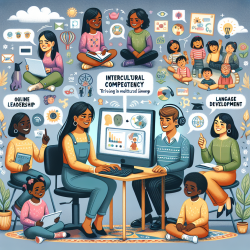Unlocking Intercultural Competency: A Game-Changer for Practitioners
In today's interconnected world, the ability to navigate cultural differences is more crucial than ever, especially for practitioners in fields such as speech-language pathology and online therapy. The research article "Leading across cultures in the human age: an empirical investigation of intercultural competency among global leaders" provides valuable insights into the competencies required for effective leadership in multicultural settings. This blog explores how these findings can be applied to improve outcomes for children in therapy.
Understanding Intercultural Competency
The study identifies six key intercultural competencies that predict leadership success: Respecting Beliefs, Navigating Ambiguity, Instilling Trust, Adapting Socially, Even Disposition, and Demonstrating Creativity. These competencies are not only applicable to global leaders but also to practitioners working with diverse populations.
Implementing Competencies in Practice
Practitioners can enhance their effectiveness by integrating these competencies into their practice:
- Respecting Beliefs: Acknowledge and respect the cultural and spiritual beliefs of the children and families you work with. This fosters trust and a positive therapeutic relationship.
- Navigating Ambiguity: Be open to different communication styles and cultural norms. This flexibility can lead to more effective therapy sessions and better outcomes.
- Instilling Trust: Build and maintain trust with clients by being transparent, reliable, and culturally sensitive.
- Adapting Socially: Engage with families in a culturally appropriate manner, showing genuine interest in their backgrounds and experiences.
- Even Disposition: Maintain a calm and positive demeanor, which can help in managing challenging situations and reducing stress for children and their families.
- Demonstrating Creativity: Employ creative strategies that are culturally relevant and engaging for children from diverse backgrounds.
Encouraging Further Research
While the study provides a strong foundation, further research is encouraged to explore how these competencies can be tailored to specific cultural contexts within therapy settings. Practitioners are urged to engage in continuous learning and adaptation to meet the needs of their diverse clientele effectively.
Conclusion
By embracing intercultural competencies, practitioners can enhance their ability to deliver effective therapy services to children from diverse backgrounds. This not only improves therapeutic outcomes but also contributes to the development of culturally competent professionals.
To read the original research paper, please follow this link: Leading across cultures in the human age: an empirical investigation of intercultural competency among global leaders.










